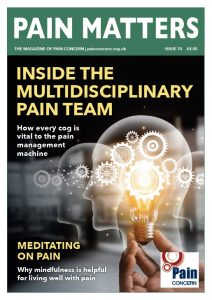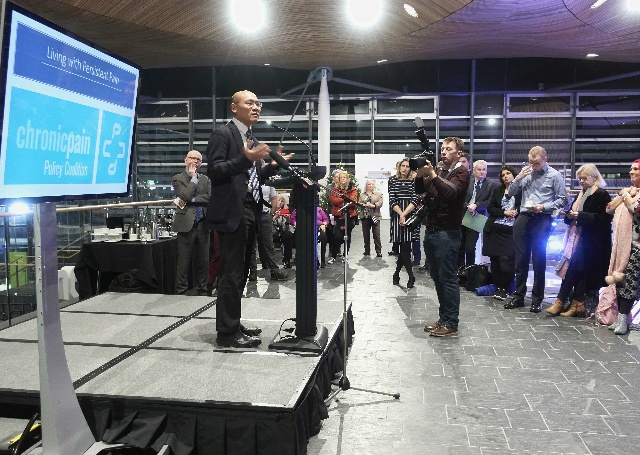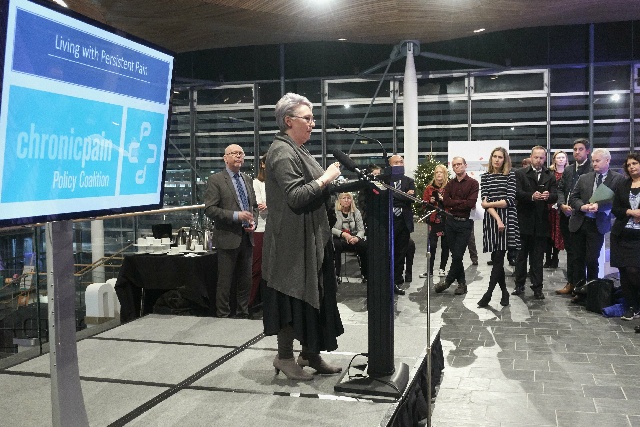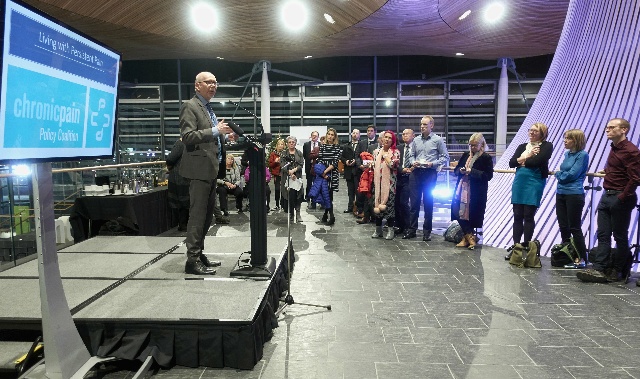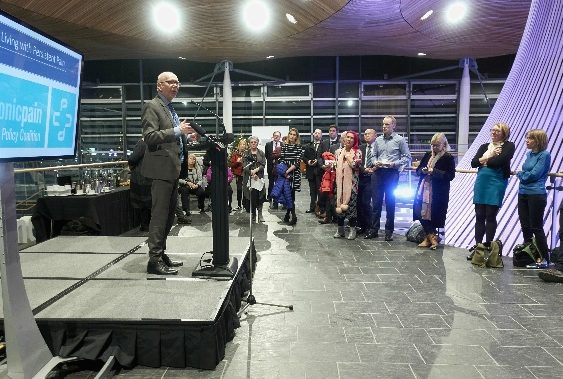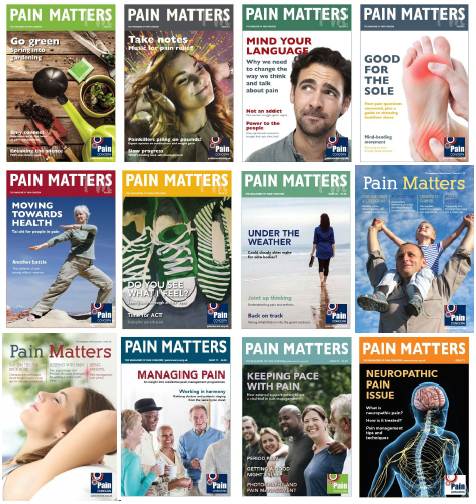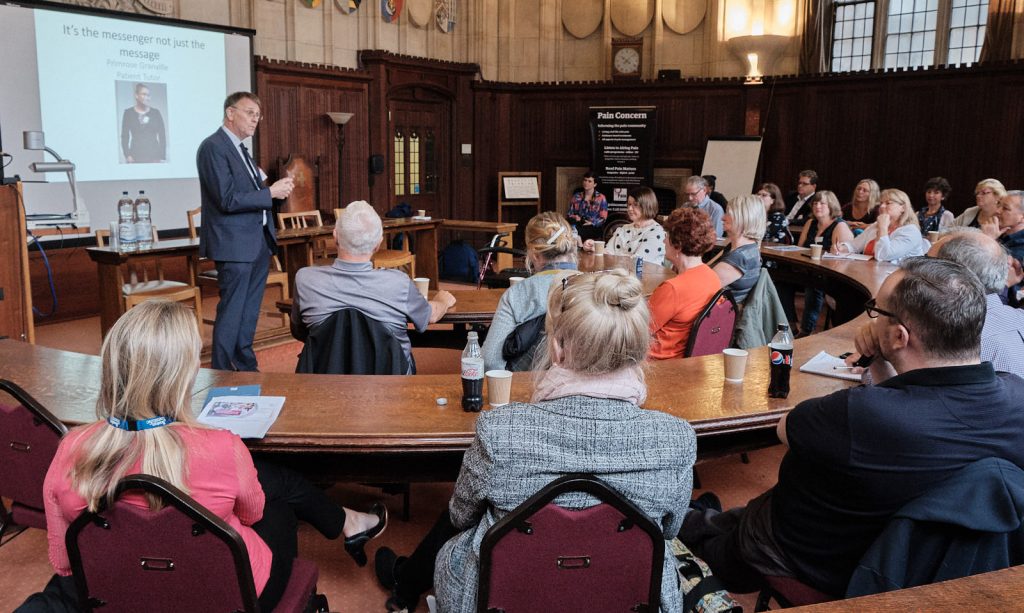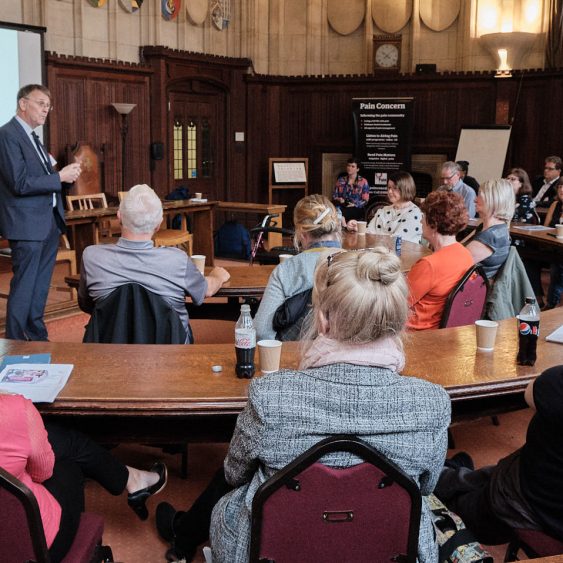Exploring neuropathic pain and the various ways it can be managed
To listen to this programme, please click here.
In this edition of Airing Pain, Paul Evans investigates the ideas behind Pain Management Programmes, and highlights the importance of the patient in shaping their own treatment.
Internationally recognised Professor Srinivasa Raja speaks to Paul about the differences between nociceptive and neuropathic pain, as well as the complexities of chronic pain and its management.
Consultant Clinical Psychologist, Dr Clare Daniel examines the psychological and social components of chronic pain. She discusses the important role of the cognitive behavioural model in Pain Management Programmes.
Paul speaks to lead physiotherapist Diarmuid Denneny about the importance of the patient in determining the appropriate response to their pain, by taking into account their life and personal aspirations.
Finally, Cameron Rashide, a patient with neuropathic pain among other conditions, speaks of the pain management technique ‘pacing’ and how she has learnt to manage her pain through pushing herself ever so slightly outside her comfort zone.
Issues covered in this programme include: After a stroke, post-herpetic neuralgia, shingles, post-surgical pain, brain signals, emotions, exercise, loss of sensation, mindfulness, nervous system, neuropathic pain, nociceptive pain, numbness, pacing, psychology, tissue injury and trigeminal neuralgia.
Paul Evans: This is Airing Pain, a programme brought to you by Pain Concern, the UK charity providing information and support for those of us living with pain, and for healthcare professionals. I’m Paul Evans.
Clare Daniel: A good pain management programme is about responding to what the people bring. So when I was really interested in setting up a programme for people with neuropathic pain, people said to me, ‘Why are you doing this on diagnosis?’
Diarmuid Denneny: It’s well known that people with neuropathic pain wouldn’t tend to do as well on our general pain management programmes. Their outcomes from all the different measures weren’t as good, or as expected.
Daniels: I wanted to do it because of the differences I observed tailoring our intervention to what they were coming with.
Evans: Neuropathic pain is caused by nerve damage or nerve disease. It’s often described by those who have it as burning, aching, or like an electric shock. Many experience pins and needles, numbness and weakness. For some, it’s a stabbing pain in the middle of the night. For others, it’s a burning feeling felt throughout the day. Amongst other causes, it can be caused by shingles, diabetes, surgery or a stroke.
In May of this year, that’s 2019, the International Association for the Study of Pain brought together the world’s leading experts on neuropathic pain in London to share experience and knowledge. One of those is Professor Srinivasa Raja of Johns Hopkins School of Medicine in Baltimore in the United States. He’s internationally recognised for his research into neuropathic pain.
Srinivasa Raja: The International Association for the Study of Pain defines it as pain that results from a disease or injury that affects the somatosensory system. And that big term ‘somatosensory’ actually just means anywhere in the pain signalling process, from the periphery, which could be at the level of the skin, to the brain. The injury or the disease can affect anywhere in that process. Some good examples would be pain that persists after shingles, or herpes zoster, what we call a post-herpetic neuralgia; or a condition after a spinal cord injury; or after a stroke. So here we see that, like in herpes zoster, it’s initially a skin legion that affects the peripheral nervous system. In spinal cord injury it’s the spinal cord, but in stroke it’s the brain. So all of these, or injuries anywhere along this nervous system can lead to neuropathic pain.
Evans: The other term I’ve heard is nociceptive pain, how does it differ from that?
Raja: Nociceptive pain is that pain that could result from an actual or potential injury to tissues. Could be as simple as a pinprick, it could be a burn, or after a surgery, the immediate pain after surgery. So this is usually associated with a tissue injury mechanism.
In contrast, neuropathic pain specifically involves an injury to the nervous system. So, the main difference is what initiates and what causes the pain. But the patients also describe the pain differently, often. The neuropathic pain, there could be an area where the patient says, ‘I’m numb’, but immediately adjacent to it, even touching that area causes pain. So, this kind of challenging situation, where there is loss of sensation as well as amplified, or increased, sensation that coexists is typical for neuropathic pain.
Evans: So if I bang my finger, hurt my finger, that hurts, that sends messages up to my brain that he’s just banged his finger and the brain will translate that into pain. But that pain will go. It will heal. [Yes]. Neuropathic pain stays?
Raja: Not all neuropathic pain stays chronic. There may be some situations which we now call acute neuropathic pain, where the pain may gradually disappear with time. A good example of that may be the phantom pain that usually occurs after an amputation. Most patients, immediately after the surgery, or after the injury, will experience that sensation of pain in the missing part of the limb. However, the majority of those patients seem to resolve in time, it’s only a smaller subset of those patients who persist, and go on to chronic pain.
So the good thing about it is it seems that the body has some protective functions, and in most cases, fortunately for us, the pain resolves with time. It could be weeks to months. But in some cases these pain states persist, and it is this chronic pain state that becomes problematic to most patients.
Evans: So how do you deal with that?
Raja: One of the first aspects of dealing with patients with chronic pain is an appropriate assessment of their problem. An assessment includes not only the description of the pain experience, how they perceive it, but also functionally how this pain affects their quality of life, their day-to-day functioning. In most cases also examining the psychosocial comorbidities, one of the most interesting things is that the pain experience is different from individual to individual given the same injury, and therefore one has to assess what are the other environmental psychosocial factors that may also contribute to this chronic pain experience.
Evans: They call that the biopsychosocial model for pain, where everything around us, our bodies, our society, things that happen in the street and at home, everything feeds in to the pain.
Raja: A few decades back, neuroscientists, people trying to understand the pain mechanisms, thought that this was purely a biological mechanism. That there was injury to tissues, there were certain nerves that were excited, which resulted in the sensation of pain. What we have learned over the last several decades is that it’s much more complex, and that the experience of pain is modified, or modulated, as we call it, by a number of factors. It could be genes, it could be psychological environment, social environment, their prior experiences, and so it’s much more complex that a sensation or just trafficking or signals that go along pain pathways.
Evans: That’s Professor Srinivasa Raja of Johns Hopkins School of Medicine in the United States. We’ll be talking in greater detail about his, and others’, research about neuropathic pain in a future edition of Airing Pain. But in this edition I want to concentrate on those psychological and social components of chronic pain.
Doctor Clare Daniel is a Consultant Clinical Psychologist. Now leading psychological services at Buckinghamshire Healthcare NHS Trust, she previously worked at the National Hospital for Neurology and Neurosurgery Pain Management Centre in London.
Daniel: Psychologists tend to work with the cognitive behavioural model on different variations, and actually, the physiotherapists do as well, if they’re working in pain services. So the cognitive behavioural model, if you just picture a cross, on the four ends of the cross there are four words. One is thoughts, one is emotions, one is behaviour and the other is body. Ok, so thoughts, emotions, behaviour and body, and the idea is that they are all influencing each other. If a person’s fearful, their emotion is fear and they have chronic pain, the chances are that fear is going to turn up the volume, or the intensity of that pain. So that person needs to have input from a body practitioner, which might be a physiotherapist, but obviously thinking psychologically, but also a psychologist. Because you need to address the thoughts and the emotions, which is the psychology part of it, and the behaviour and the body, which is the physio part of it. But in an integrated way, because if you go to a non-pain service you’ll often get the psychologist that will just focus on thoughts and emotions and the physios that just focus on body and behaviour.
Evans: So it’s thoughts, emotion, behaviour and body.
Daniel: It’s just getting people to think about the likelihood of the influence, because actually, one cognitive behavioural model, which is acceptance and commitment therapy, is really trying to separate thoughts and emotions from behaviour. So regardless of what you’re feeling in terms of emotions about your pain, so ‘I’m really frightened about my pain, I can’t do something’, the intervention is to try and keep going with the behaviour, because it fits in with your values.
It’s about thinking about the interaction between the four, and in some respects can you just loosen that interaction. A classic example with neuropathic pain is even if people just experience the sudden electric shock type pain, trigeminal neuralgia (TN) is a classic example, they can be pain free for a long time, but their pain is still massively impacting on them during pain free times. A lot of the time it’s because of the thought, ‘well if I go outside, and if I get a sudden shock of TN, I might be stranded, no-one’s going to help me, I can’t get home, I might not have my tablets’. So it’s that fear and that prediction that make them stay, understandably, at home.
Evans: I would think that’s a perfectly natural way to think. ‘I won’t go out today, what happens if I have a flare up away from home?’
Daniel: I always say when I work with people, is that their responses to their pain are totally natural and understandable. Because acute pain is a warning sign; it’s signalling danger. Chronic pain, it’s not, but that’s how our bodies and brains are wired, to see pain as a danger. So therefore of course we’re going to want to protect ourselves, and not put ourselves in danger.
But we have to change that link or belief with chronic pain, that it’s pain but it’s not dangerous. And we can help you to build up your confidence, to manage the pain if you go outside today.
Evans: Clare Daniel.
Diarmuid Denneny is Physiotherapy Lead at the National Hospital for Neurology and Neurosurgery Pain Management Centre in London.
Denneny: The main role of physiotherapy in pain management, whether it’s neuropathic or another type of chronic pain, is around helping people to understand the pain, why the pain lasts, why it hasn’t gone away. And there are often key messages that we would weave into that part of our work, which are around, it’s possible to experience pain even though the body is no longer experiencing damage, or being damaged. And that the amount of pain that we feel doesn’t necessarily equal the amount of injury that our body has, if it was injured, sustained.
So around the understanding of the pain, and in order to do that we need to understand the person and their life, and what’s important to them, and what the pain is stopping them from doing. So that we can start to work out, and I should say we work very closely with psychologists in pain, so we try to work out what’s important to the person who is experiencing the pain, that they are no longer able to do, or that they find difficult to do. And to work out ways to do that, and that’s when we start to think about the physical activity, or the ability to do things. And there’s a reality that most people, by the time they get to meet with a physiotherapist who specialises in pain, will have encountered many physios before that – an average of four or five is a figure I’ve often heard. And so they understandably come somewhat wary or reticent – this idea [of] ‘not another physiotherapist’. Often they’ll have tried to do things with physio and they may have experienced their pain increasing or getting worse, not getting rid of the pain. So the work we do might be to help people to understand that although they’re here because of pain, we might shift our focus more to what they want to be able to do, and look at ways to do that. Which may include looking at movement, and how to move in a way that allows them to build up their activity levels. And activity levels doesn’t necessarily mean going to a gym or doing a prescription of exercises, it can be being able to hang up the washing at home, or to play with their grandkids, or to do their work, which might include an element of physical activity, standing all day, or whatever it is. So we try to explore a bit about activity and exercises, not just going to a gym, but looking at things that fit into their lives.
Evans: I guess something as simple as getting out of bed is an activity?
Denneny: Absolutely, because the centre here is a specialised pain service, so we’ll often see people who’ve been to other pain services first. And their activity levels can be really, really, really affected by pain. Many people will say they have to spend all day in bed with pain, so a starting point might be thinking about sitting up in bed.
Evans: That was physiotherapist Diarmuid Denneny.
Cameron Rashide: It’s been eight years since I’ve stopped working. In the last eight years I literally stayed at home because the pain is too much for me. I stopped going out to coffee shops, and wouldn’t go out shopping on my own – everything online. Literally it was: hospital, home, hospital, doctor, hospital, home.
Evans: Cameron Rashide is a participant on the COPE pain management programme at the pain management centre in London. COPE is group based and focuses on self-management, building upon skills to help people reduce the impact that pain has on their lives.
Rashide: It’s basically living, breathing with your chronic pain. Even though you’re in pain, don’t think that the pain takes you, you take the pain. You have to decide what you can do with it.
Evans: How do you do that?
Rashide: So basically, on this we’ve learnt different skills, we’ve learned to pace ourselves, we’ve learned to cope with feelings and structures. So you have the thought, the feelings and the behaviour. The thought always will be – ‘I can’t do this, I don’t think I can do this’. The feelings will be – ‘ok I want to do this, but can I do this?’. So then the behaviour is actually putting them two in action, and adding the ‘and’ into it, and saying ‘I think I can do this, but if I try this and I try this, I can get to…’ In other words, instead of saying A-to-B, you can’t get there on its own, you need the ‘C’ there, so it’s trying to put them all together.
Learning the skill of just pushing yourself just a little bit, but not too much. Pacing. The golden word, pacing.
Evans: That’s the theory. How are you putting it into practice? And how’s it affecting you?
Rashide: There’s other skills, they’ve asked us to go outside the box that you normally would do since you’ve been in pain. Now this has taught us to practically do something outside the box, like last week my weekly goal was to go to a coffee bar, and I did that. Even though I wasn’t comfortable, I was in pain, but it was enough to pace myself, but not overdo it. So it’s little goals, but achievable goals.
Evans: Well, amongst other conditions, like fibromyalgia, Cameron has neuropathic pain. But there’s a growing body of evidence that people with neuropathic pain don’t do as well on general pain management programmes as those who have other chronic pain conditions. Clare Daniel.
Daniel: I was quite new to pain services and I hadn’t quite realised the difference between neuropathic pain and non-neuropathic pain. And I noted this group of patients, they didn’t quite do as well in the programmes. Some people left the programmes, dropped out, because they just felt as though what we were saying didn’t fit with their experiences. So, ‘I’m different from everybody else in the programme’. And then I began to realise that ‘Well, these are often people with neuropathic pain’. So I looked at the differences between a group of people with non-neuropathic pain and people with neuropathic pain, and actually the main difference is the pacing can help, but doesn’t necessarily help them. Please don’t think I’m saying ‘Don’t pace at all’ because it can be very helpful, but some people don’t feel as though it’s helpful, or it’s unpredictably helpful. And the other thing is the sudden pain that just suddenly comes on. So my gut instinct at that point was that if they can begin to respond differently to their sudden pain, as opposed to what often happens of sometimes literally falling to the floor, or curling up in a ball, if they could stay in the present, remain mindful, learn strategies just to keep them present. Not become very fearful about ‘My pains suddenly there, what’s going to happen?’. Begin to respond, I guess much more gently on themselves, and differently.
Denneny: Asking people with neuropathic pain what would be helpful, and they did express wanting to understand more about the nuts and bolts of the nervous system and how that might be contributing to their pain. So I suppose broadly we agree that it would be helpful to go into more detail on that aspect of the body as part of the programme. So if we call it psychoeducation, we thought that would be useful to include in the programme. Mindfulness uses a certain type of language – if you think about neuroplasticity, which is, broadly speaking, the way that the nervous system is constantly adapting to its environment, and the effect of the environment on the nervous system. So it’s always changing all the time, which is to me tremendously hopeful [laughs].
A lot of the factors that are most helpful for the nervous system, in terms of that neuroplasticity, are around novelty, are around being engaged in a community; so going out and about. They’re around repetition; they’re around focus. And if you think about that in the language of mindfulness, it’s saying the same things really, in terms of what you do. So we thought maybe it would be useful to apply some of those strategies within a programme. So that’s what we set up, and we piloted it for the first three or four weeks [cut off] – 20 patients – and we found that their outcomes, whereas previously they were slightly below what we would have expected, they kind of matched, or exceeded the general scores that we would expect.
Daniel: Astounding in a couple of cases, I remember.
Evans: So basically, the difference between a neuropathic pain management programme and a non-neuropathic pain programme is just how to handle the different ways that pain comes?
Denneny: So around these sudden, severe episodes of pain, feedback almost consistently is actually, the most helpful thing in those moments is to bring my awareness to my breathing. Because it’s a reality with these that they are very sudden, severe, quick, and then they go away almost as quickly as they’ve come. And by the time you’ve got to your medication or other things that might be helpful, it’s settled back down again. So in terms of responsiveness, we’re always carrying our breathing with us all the time, so it’s something that we have access to and we can drop into.
It doesn’t work for everybody, it’s important to point that out, it’s not a panacea or something that is going to work for everybody, but for those who’ve come on the programme, that’s the one thing that they tend to really value and find helpful. So there’s something about strategies and the symptoms that people experience, and then there’s something about the information that we give on it is perhaps more information than you might think is helpful on a general programme. We always give people resources and they’re free to read as much or as little as they want to, or to explore as much or as little as they want to, but we’ve found people with neuropathic pain, they tended to want to know more about what’s going on in the nervous system, how does it change, why does it change, and how does it explain these symptoms.
Daniel: A good pain management programme is about responding to what the people bring. So when I was really interested in setting up a programme for people with neuropathic pain a lot of people said to me, ‘Why are you doing this on diagnosis?’. Of course, I was, because I was separating neuropathic pain from non-neuropathic pain, but that’s not the reason why I was doing it. I wanted to do it because of the differences I observed, so what people were coming with. They could have been diagnosed with anything, but it didn’t really matter to me, it was about tailoring our intervention to what they were coming with.
Evans: This is a very broad question, but what would you consider to be a successful treatment?
Denneny: It’s really down to the person with pain to decide that. In the days of Alastair Campbell I used to think we were trying to help spin things a little bit, by saying ‘Ok you’re here because of pain but we want to focus on what’s important to you’. And in a sense that is what we’re doing, so success would look like somebody achieving the goals that they’d set themselves during their time with us. And maybe not even during their time with us, but having on their last session a very clear ‘I’m not there yet but I know what I have to do, and this is my plan to get there’.
Evans: Establishing what goals a person sets for himself or herself – that can be a very difficult thing because somebody coming to a specialist unit like this might think, well, ‘My goal is to climb Everest’, ‘My goal is to do the London marathon’. How do you sort out expectations?
Daniel: When I first starting working in pain, which was a long time ago, we just focussed on goals and people did find that very difficult, particularly people from different cultures with English as a second language, a goal might mean something very different. More in the last seven to ten years we’ve talked much more about values. And values are some things that are really important to us, and it might be developing, learning, health – they tend to be one word. So it’s about something that we’re continuously aiming towards in our life. We never actually quite reach them, we’re just continuously going towards those.
And then goals are shorter steps in the pursuit of those values, in line with those values. In terms of realistic goals, we talk about short term and long term goals, because as Diarmuid said, when people finish the programme it’s not finished, they will continue, hopefully, to improve in terms of quality of life, reducing the impact of pain. So we’re very clear about short term steps. We do talk a lot about the fact that that might be frustrating to people because they want to get up and run, run before they can walk, literally sometimes. And we do talk very much about realistic expectations. When we talk about goals we talk about SMART goals, the acronym SMART.
Evans: SMART is?
Daniel: So, S stands for specific, so a very specific goal – so not just, ‘I want to swim’. It might be ‘I want to swim two lengths three times a week’. It doesn’t matter. It’s absolutely set by the person with pain. It’s not set by us. So – specific. Measurable, so that you know when you’ve achieved it: so the number of lengths that you want to, for example, swim. Achievable – think about this, is it really achievable with what you’ve set in the timeframe that you’ve set it, ‘Can I swim two lengths by, let’s say six weeks’ time?’. And then the R could be, people often say realistic, personally I think that’s quite similar to achievable. I think relevant’s quite a good one, so ‘Is it relevant to me? Does it fit with my values? Does it fit with what I want to achieve in life? Is it relevant to me?’. And then the T is timeframe or time bound, so ‘When do I aim to achieve this goal by?’. But we’ve also started to talk about that having to be flexible, so we often put an F on the end of SMART [laugh], because people do have high expectations of themselves, they can get very frustrated, life can throw things at them and the measures, or the timeframe that they’ve set for their goals can go awry. And that’s quite normal, that’s life, so we help them to be flexible and think, ‘Well, ok, if you need to push that back a bit, that’s fine’. But what we don’t want is for them to keep pushing back and back and back and never achieve.
Denneny: With pain there’s this idea that doing something that you want to do, that’s important to do, often that you have to do, just because real life means we have to do things, afterwards experiencing an increase in pain. Some people call that boom bust cycle, some people talk about activity cycling, where they do more and then have a period of not being able to do as much. We talk a lot here about flare ups or pain flares. This is terminology, different people have their own preference for what they want to call that. And I suppose for us, working with people with pain, the important thing is to acknowledge that they’re [flare ups/pain flares] a normal part of living with long term pain. They will happen. They don’t mean that things are necessarily getting worse because they are a normal part of the condition over time. And so the challenge is, and what we work a lot on with people, is learning ways to manage, as best they can, so that they get through these flares without having an impact on their ability to manage that sets them back.
Daniel: But also, specifically with neuropathic pain, I think it’s important to help people understand that neuropathic pain, for a lot, not everybody, it can come suddenly. It just suddenly happens with no specific warning. Whereas non-neuropathic pain, not always, but it can just gradually increase and the person knows it’s beginning to increase. So, it’s important that the person recognises that a sudden increase in their neuropathic pain is actually normal. That’s not necessarily related to the boom and bust activity cycling.
Denneny: That is really important, yeah. And again going back to what we do with people, it’s to help try and separate what the pain is doing from what they do day-to-day. Because more than any other group that we work with, people who have neuropathic pain really struggle because often the classic is, ‘Well it doesn’t matter what I do, it’ll either hurt a lot if it’s hurting a lot’, or ‘It doesn’t make any difference’ so much.
So, some of our more, what could be considered traditional strategies for working with people with chronic pain, people who have neuropathic symptoms often struggle, particularly pacing.
Daniel: Yeah, because pacing can be quite, less so nowadays, but it can be quite prescriptive. In the olden days it used to be about people increasing their activity levels, mainly within time. So it might be that you walk for one minute, have a rest, then walk for another minute, and gradually over days, weeks, months, increase that. But some people with neuropathic pain say, ‘Well that doesn’t make sense to me. Regardless of what I do, regardless of how far I walk, even if I’m just sitting down and not walking, my pain will suddenly increase. But sometimes I can walk five minutes and its fine’. So pacing for some people makes less sense, but I think the message therefore has to be a bit more flexible and it’s about, ‘It’s safe to move’. Your pain will increase at times, but then what can you do when it does increase, to help yourself, either mood not suddenly plummet, or giving yourself a hard time.
Denneny: Or stopping doing something because, unfortunately, has it happened at the time you were doing something and you’ve made that link that doing that is what caused it, which isn’t always true.
Evans: That’s physiotherapist Diarmuid Denneny and psychologist Clare Daniel.
For more information about pain services at The National Hospital for Neurology and Neurosurgery Pain Management Centre, including their pain management programmes, put the letters U, C and L, that’s University College London, with the words ‘pain management centre’ into your search engine.
I’ll just remind you as I always do, that whilst we in Pain Concern believe the information and opinions on Airing Pain are accurate and sound, based on the best judgments available, you should always consult your health professional on any matter relating to your health and wellbeing. He or she is the only person who knows you, your circumstances and therefore the appropriate action to take on your behalf.
Now, to end this edition of Airing Pain, what advice would the team give for those who don’t have access to a specific neuropathic pain management programme?
Denneny: There are lots of resources out there in terms of exploring things like mindfulness based pain management approaches they could look at. It’s being flexible with the pacing, or this idea of building up activity, that holding that lightly, if that’s possible. That it’s good to be active just generally for all sorts of other reasons.
Daniel: And safe, it’s safe to be active.
Denneny: It’s safe, yeah, really important.
Daniel: That’s a big important message, ‘I’m not going to do any more damage, I’m not going to do damage’. So a lot of the non-neuropathic principles absolutely apply to neuropathic. And I’d say this to any person with pain, if they’re accessing online resources or self-help materials, about taking what is useful for them.
Evans: And that it’s trusted.
Daniel: Yeah, an evidence based approach is absolutely essential.
Contributors:
- Dr Clare Daniel, Consultant Clinical Psychologist, Buckinghamshire Healthcare NHS Trust
- Diarmuid Denneny, Physiotherapy Lead at the National Hospital for Neurology and Neurosurgery Pain Management Centre in London
- Professor Srinivasa Raja, Johns Hopkins School of Medicine, USA
- Cameron Rashide, patient who lives with chronic pain.
More Information:


